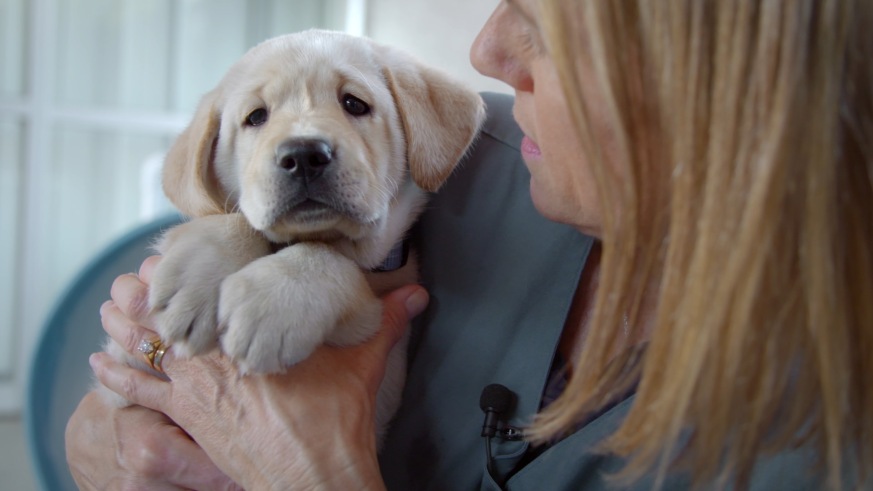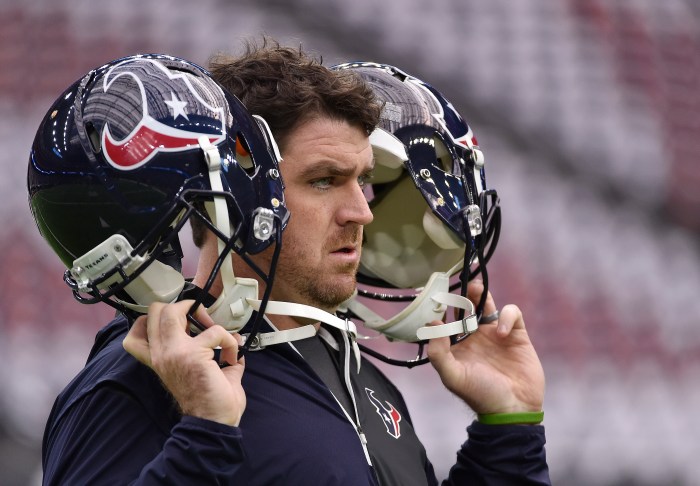Pick Of The Litter is a movie that will immediately make you go, ‘Aww!!!’
In fact, if you don’t immediately find yourself overcome with emotion and warmth at seeing the birth of a brand new guide dog then “Pick Of The Litter” is completely and utterly wasted on you.
Since “Pick Of The Litter” tells the story of five puppies going through the rigorous training regime required to become a guide dog there are cute moments littered throughout. But what’s most surprising is just how cut-throat the entire process is.
I recently had the chance to talk to “Pick Of The Litter’s” directors Dana Nachman and Don Hardy, and this is what they had to say about their adorable yet ruthless documentary.
How did you get started on “Pick Of The Litter”?
Dana Nachman: So Don and I were journalists at the NBC studio in San Francisco, and we had done numerous stories on guide dogs for the blind. One was a graduation, we followed a family that raised puppies, and we always knew it was adorable and cute and that it could be a bigger story than the 3-5 minutes could be. My mum was a newspaper reporter over in New York, who did a series, just like we did in “Pick Of The Litter,” following a litter of puppies from the day they were born to whether they made the cut. So we thought we would steal from the best and steal from her.
What did you want to achieve with the documentary then?
Don Hardy: Just a deeper dive into the beginning to end process. Our short pieces were focused on one specific thing. We wanted to see from birth what it really takes to make one of these incredible animals. What surprised us is just how big the community is that surrounds it, and how committed they are to the mission. In the beginning there are a lot of volunteers, who go in there and cuddle the puppies for the first few months they’re alive. Then there’s volunteer puppy raisers that take them into their homes for the first 12-14 months once they leave the campus. Then the pros come in to finish it off. When they get back to the campus, and go through the really intricate training. So just finding that whole human community around the dogs was really a surprise.
Dana Nachman: We are just big fans of the competition films in general. The “Hoop Dreams” and “Spellbounds” of the world. So we always loved that structure for the film. And we were like, ‘This is great. A competition film with dogs? We can’t miss.’
There are moments of ruthlessness in the film that are pretty surprising, too.
Dana Nachman: Yeah, it is not for wimps. They don’t bend the rules, they don’t do things to make you feel good, because it is a life and death situation. So, on one hand it is a cute movie about dogs, but on the other it has life and death stakes. So that was really exciting, because as filmmakers we are always looking for stuff with those stakes.
Don Hardy: It is really about giving the dog the best circumstances to succeed. If that means hurting the feelings of some humans, that’s OK. It is whatever makes the dog the best they can be.
Dana Nachman: All the humans take it so seriously. There was always, in our minds, a “Best In Show” quality to the whole process. We loved that. There’s a little of that that ends up in the film. Because obviously “Best In Show” came from somewhere.
How long did you film for?
Don Hardy: 120 days of shooting over 2 years. That was several hours a day. That’s more than we are used to filming. But we were looking for little differences. Where the dogs did great or not so well. It took a lot of shooting to make those happen. One of the big things that we needed to make sure didn’t happen was that we didn’t want to get in the way. Obviously having a camera there does innately make people change. But we never asked them to stop, or do something again, so that created a unique set of challenges.
Were you ever concerned about being in the way when the guide dogs were training? Did you ever consider taking a different approach?
Dana Nachman: Yeah, we were conscientious of that the whole time. Don rigged up this gear that we developed just for this film, which allowed us to get very close to the dogs, get down low to the dogs, be at dogs-eyed view. That entailed us being very close to them. We were worried that we would get in the way. Sometimes when they had pivotal tests we would hang back a little bit, just so we weren’t in the way. But it turns out that if they were distracted that day it wasn’t really because of us. It is because they weren’t really on the ball. So it was less of an issue than we thought. Guide Dogs was really great about it. Because, think about it, we just left a guide dog in Manhattan, and there are a million and one things to distract it. So they just labelled it as another thing that could distract it and that was a great way of thinking about it.
What was the biggest challenge when it came to assembling the documentary then?
Don Hardy: Just distilling it to the best moments that were there. In some ways getting fresh eyes on it. Because not only did we shoot the whole thing, we edited it, too. We had some great supervisors that came in, told us where it got a little redundant, and helped us to streamline it into hopefully becoming the best film it can be. That was a challenge, sorting through it all and finding those best moments.
What was the biggest lesson you took away from the film?
Dana Nachman: One of the reasons I think the topic is so compelling is; all dog lovers, we benefit from them, that’s why we have these pets. And being a guide dog is the ultimate canine career. Because these dogs have to 100% of the time. Until there is one moment in their career where they have to disobey their handler. That would be if the handler was disorientated and is about to walk down a subway platform, or down stairs or into traffic. These dogs might have learned what they call intelligent disobedience 5 years prior in their training, and they will take those skills out at the moment they need them and disobey. They’re obeying 100% of the time, to one or two moments when they have to disobey. That’s just incredible. So to think about the small but profound benefits that we all get from pets to that level of benefit and the freedom they give people is amazing.
Don Hardy: These are very special animals. I want people to realize that this is an animal that has been trained from day one to do something that could save somebody’s life. I hope people that come away from the film realize how important these animals are.
What do you want audiences to take away from “Pick Of The Litter”?
Don Hardy: I just hope that people go out to see it in theatres wherever possible. Because i think that this is the kind of movie that benefits from that shared experience. It is a rollercoaster of a film, and it is so heartening as filmmakers to see people reacting to it the way they are. They are in it from the opening shot with a big, ‘Aw!’ And then there are tears and cheers and wild applause. In all of my movie going experience I have never seen an audience applauding at a screen in this fashion. Even if we hadn’t made it I would be thrilled to be a part of the audience of it.
Dana Nachman: It is such dark dreary times in the world, and we hope that this is an hour and a half where you can forget about that and root for these cute puppies.
“Pick Of The Litter” is released on August 31st.

















